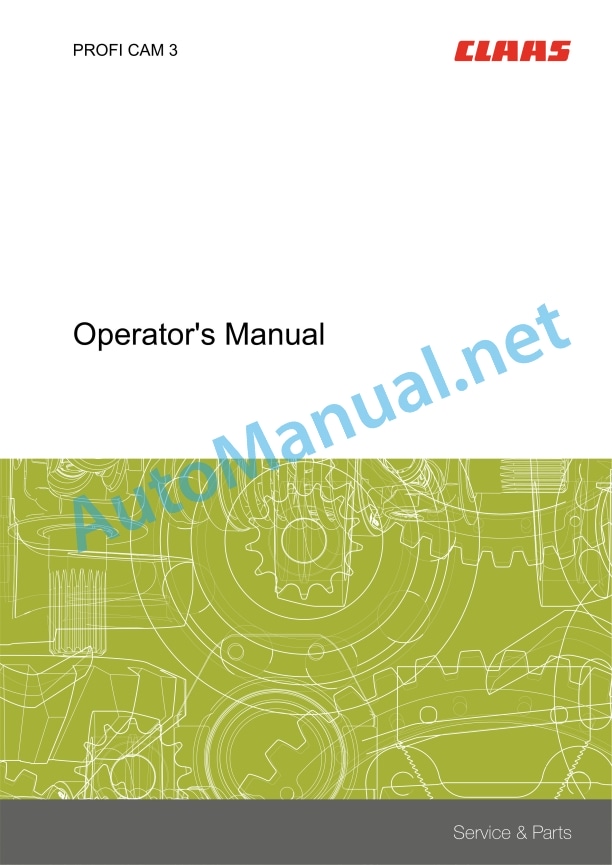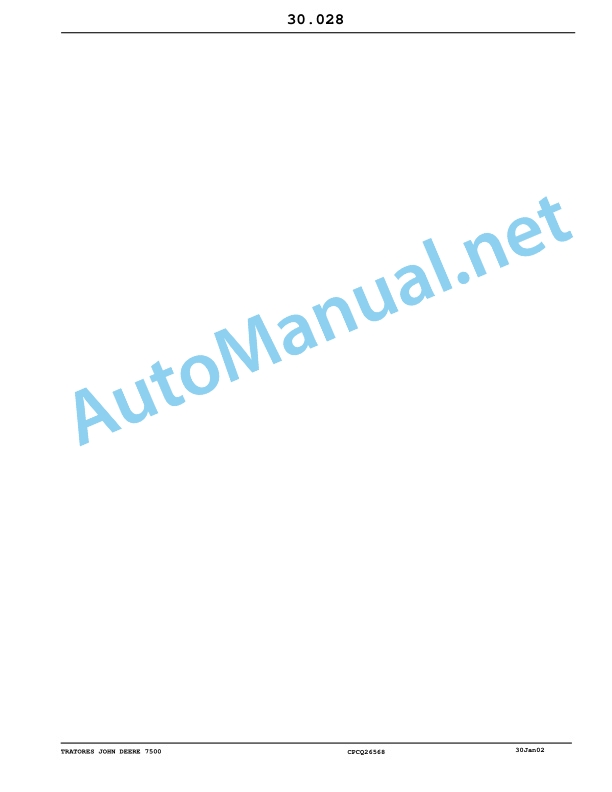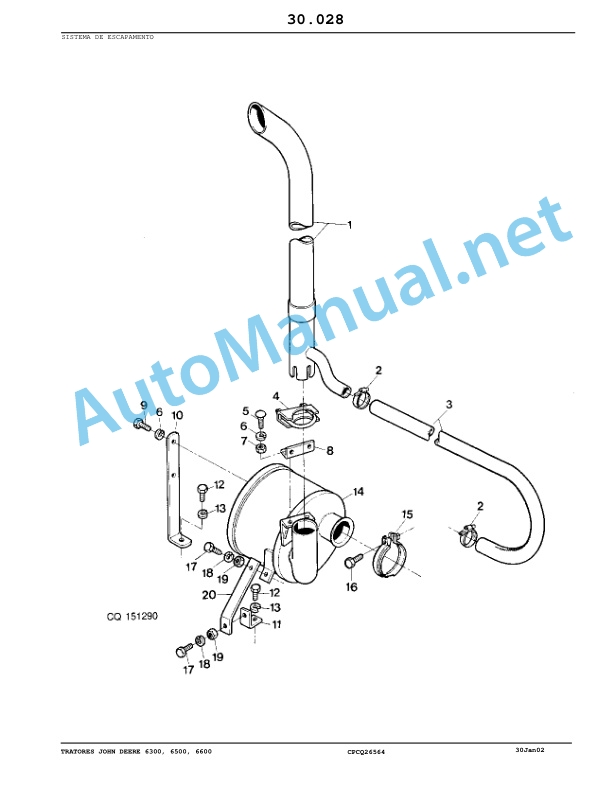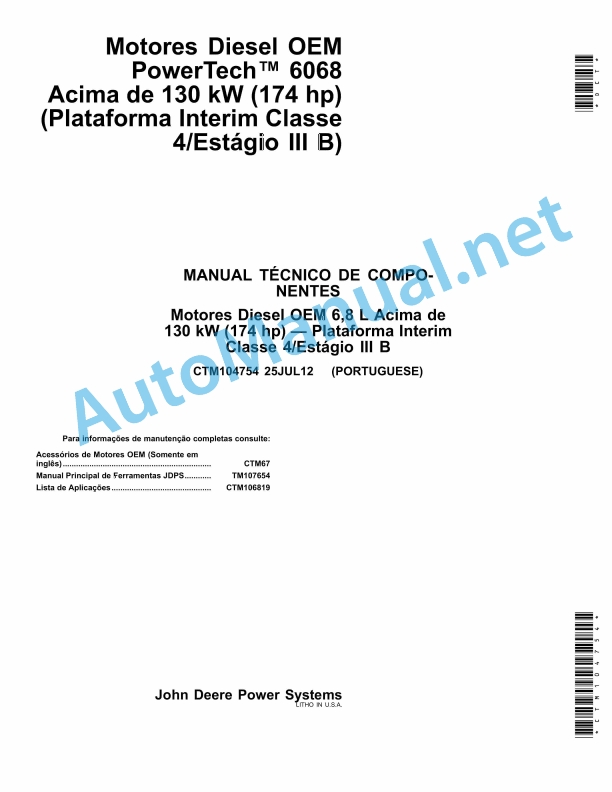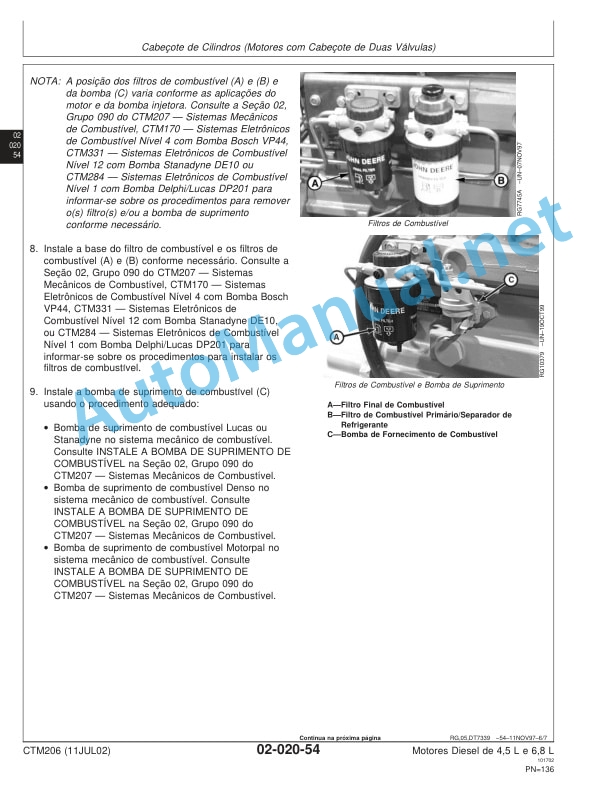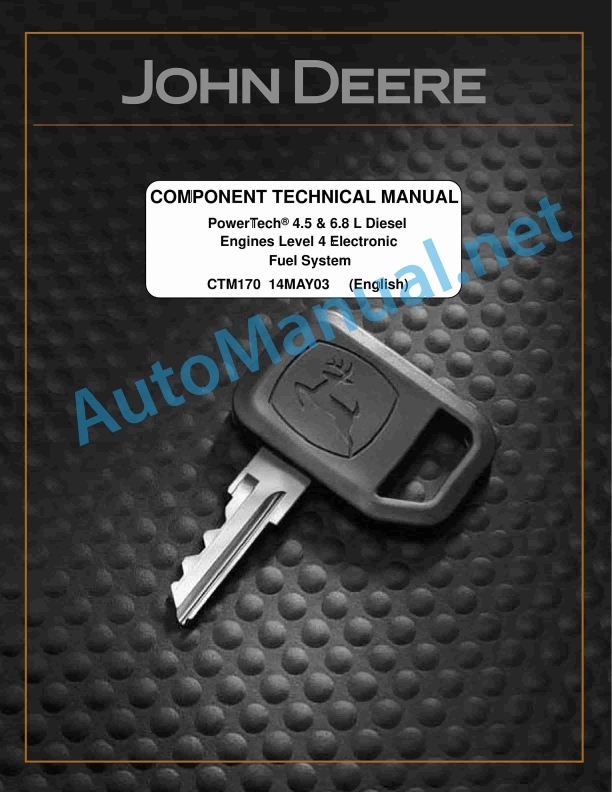Claas Variant 585-580 (J15) Balers Operator Manual EN
$50.00
- Model: Variant 585-580 (J15) Balers
- Type Of Manual: Operator Manual
- Language: EN
- Format: PDF(s)
- Size: 165 MB
File List:
00 0301 051 0.pdf
00 0304 387 0.pdf
00 2348 408 0.pdf
00 2348 427 0.pdf
00 0301 051 0.pdf:
PROFI CAM 3
Table of contents
1 Introduction
1.1 Notes on the manual
1.1.1 Validity of manual
1.1.2 Information about this Operator’s Manual
1.1.3 Symbols and notes
1.1.4 Optional equipment
1.1.5 Qualified specialist workshop
1.1.6 Maintenance information
1.1.7 Warranty notes
1.1.8 Spare parts and technical questions
1.2 Intended use
1.2.1 Intended use
1.2.2 Reasonably foreseeable misuse
2 Safety
2.1 Identifying warnings
2.1.1 Hazard signs
2.1.2 Signal word
2.2 Safety rules
2.2.1 Meaning of Operator’s Manual
2.2.2 Observing safety decals and warnings
2.2.3 Optional equipment and spare parts
3 Product description
3.1 Overview and method of operation
3.1.1 How the PROFI CAM works
3.2 Identification plates and identification number
3.2.1 Position of identification plates
3.2.2 Explanation of PROFI CAM identification plate
3.3 Information on the product
3.3.1 CE marking
4 Operating and control elements
4.1 Camera system
4.1.1 Camera system monitor
4.2 Menu structure
4.2.1 Main menu
4.2.2
4.2.3
4.2.4
4.2.5
4.2.6
5 Technical specifications
5.1 PROFI CAM
5.1.1 Monitor
5.1.2 Camera
5.1.3 Switch box
5.1.4 Degree of protection against foreign bodies and water
6 Preparing the product
6.1 Shutting down and securing the machine
6.1.1 Switching off and securing the machine
6.2 Prior to operation
6.2.1 Carry out prior to operation
6.2.2 Installing the sun protection
6.2.3 Aligning the camera
6.2.4 Connecting the camera electrics
7 Operation
7.1 Monitor
7.1.1 Switching on the monitor
7.1.2 Calling up the menu
7.1.3 Setting a menu item
7.1.4 Setting the image orientation
7.1.5 Setting automatic screen darkening
7.1.6 Image mirroring
7.1.7 Setting the trigger view
7.1.8 Setting the follow-up time for trigger view
7.1.9 Setting the display mode
7.1.10 Activating/deactivating a display mode
8 Faults and remedies
8.1 Electrical and electronic system
8.1.1 Overview of problems on PROFI CAM camera system
8.1.2 Replacing the switch box fuse
9 Maintenance
9.1 Maintenance intervals
9.1.1 Every 10 operating hours or daily
9.2 Camera system
9.2.1 Checking the camera system for dirt
9.2.2 Cleaning the camera
9.2.3 Cleaning the switch box
9.2.4 Cleaning the monitor
10 Placing out of operation and disposal
10.1 General Information
10.1.1 Putting out of operation and disposal
11 Technical terms and abbreviations
11.1 Abbreviations
11.1.1 Units
11.1.2 Abbreviations
11.1.3 Technical terms
00 0304 387 0.pdf:
VARIANT 580VARIANT 560
Table of contents
1 Introduction
1.1 General information
1.1.1 Manual validity
1.1.2 Information about this Operator’s Manual
1.1.3 Symbols and notes
1.1.4 Optional equipment
1.1.5 Qualified specialist workshop
1.1.6 Maintenance notes
1.1.7 Notes on warranty
1.1.8 Spare parts and technical questions
1.2 Intended use
1.2.1 Using in line with intended usage
1.2.2 Reasonably foreseeable misuse
2 Safety
2.1 Identifying warnings
2.1.1 Hazard signs
2.1.2 Signal word
2.2 Safety rules
2.2.1 Importance of Operator’s Manual
2.2.2 Observing safety decals and warnings
2.2.3 Requirements for all persons working with the machine
2.2.4 Children in danger
2.2.5 Hazard areas
2.2.6 Presence between tractor and machine
2.2.7 Persons riding on the machine
2.2.8 Hitching the tractor to the machine
2.2.9 Danger of injury from rotating shafts
2.2.10 Structural alterations
2.2.11 Optional equipment and spare parts
2.2.12 Controlling the tractor when it is running
2.2.13 Operation only after proper putting into operation
2.2.14 Technical condition
2.2.15 Danger from damage to the machine
2.2.16 Complying with technical limit values
2.2.17 Danger from continued running of machine parts
2.2.18 Keeping safety devices functional
2.2.19 Personal protective equipment
2.2.20 Wearing suitable clothing
2.2.21 Removing dirt and loose objects
2.2.22 Preparing the machine for road travel
2.2.23 Risks when driving on the road and in the field
2.2.24 Parking the machine safely
2.2.25 Unsupervised parking
2.2.26 Unsuitable operating materials
2.2.27 Safe handling of operating and auxiliary utilities
2.2.28 Environmental protection and disposal
2.2.29 Fire prevention
2.2.30 Highly dangerous electric shock from the overhead power lines
2.2.31 Electrocution by electrical system
2.2.32 Pressurised fluids
2.2.33 Compressed air
2.2.34 Hot surfaces
2.2.35 Working on machine only after shutting it down
2.2.36 Maintenance work and repairs
2.2.37 Raised machine parts and loads
2.2.38 Risks related to welding work
2.3 Safety decals
2.3.1 Structure of safety decals
2.3.2 Location of safety stickers
3 Machine description
3.1 Existing models
3.1.1 Machine description
3.2 Overview and functions
3.2.1 Left-hand side
3.2.2 Right-hand side
3.2.3 Roller identification
3.3 Safety equipment
3.3.1 Indicator lights
3.3.2 Reflective equipment
Side reflectors
Clearance reflectors
3.3.3 Jack stand
3.3.4 Folding jack stand*
3.3.5 Wheel chocks
3.3.6 Retaining cable*
3.3.7 Parking brake*
3.3.8 Locking the tailgate
3.3.9 Locking the pick-up
3.3.10 Extinguisher*
3.3.11 Main gearbox output protection*
3.4 Working and service areas
3.4.1 General points
3.4.2 Front section of the baler
3.5 Identification plate and serial number
3.5.1 Replacement parts and technical information
3.5.2 Identification number or VIN code
3.5.3 Machine identification plate
Identification plate for a machine with European certification
Identification plate for a machine without European certification
Identification plate for countries in the Customs Union (Belarus, Kazakhstan, Russia)
North America identification plate
3.5.4 Axle identification plate
3.6 General operating principle
3.6.1 Baling cycle
3.7 Information on the machine
3.7.1 Location of information stickers
3.8 Control terminal
3.8.1 CEMIS 700*
3.8.2 ISOBUS connection
3.9 Transmission and drive
3.9.1 Transmission
3.9.2 Drive
3.9.3 Drive chains
3.9.4 Drive chains
3.9.5 Pick-up drive
3.9.6 Rotor drive
3.10 Coupling frame
3.10.1 Types of hitch
3.11 Crop feeding
3.11.1 Pick-up
3.11.2 Pick-up wheels
3.11.3 Crop guard
3.11.4 Short crop plate*
3.11.5 Roller crop press*
3.11.6 Double roller crop press*
3.12 Feeder unit
3.12.1 Rotor
3.12.2 Rotor chassis with pivoting floor*
3.12.3 Cutting unit*
ROTO CUT*
ROTO CUT Heavy Duty (HD)*
Protection from foreign objects
3.12.4 Dummy knives*
3.13 Baling system
3.13.1 Bale chamber and belts
3.13.2 Soft centre
3.13.3 Managing the peripheral layers
3.13.4 Bale chamber filling indicator*
3.13.5 Moisture sensor*
3.14 Tying system
3.14.1 Tying types
3.14.2 Twine tying
3.14.3 Net tying
3.14.4 Tying feed plate
3.14.5 Tying process
3.14.6 Twine / net box
3.15 Bale discharge
3.15.1 Bale ramp
3.16 Lubricating oil system
3.16.1 Automatic chain lubrication
3.17 Greasing system
3.17.1 Manual central lubrication*
3.17.2 Electric automatic central lubrication*
3.18 Brake
3.18.1 Hydraulic brakes
3.18.2 Pneumatic brakes
3.19 Hydraulic system
3.19.1 Baler hydraulic block
Bale chamber management
Disengaging the roto*
Feeder unit management*
3.20 Equipment
3.20.1 Ladder
3.20.2 Step
3.20.3 Modules
3.20.4 Anti-theft device*
4 Operating and display elements
4.1 CEMIS 700
4.1.1 Presentation
4.1.2 Description of the
4.1.3 Description of the
4.1.4 Description of the
4.1.5 Description of the
4.1.6 Description of the
4.1.7 Description of the
4.1.8 Description of the
4.1.9 Description of the
4.2 ISOBUS terminal
4.2.1 Presentation
4.2.2 General points
5 Technical specifications
5.1 Baler
5.1.1 Dimensions
5.1.2 Weight
5.1.3 Hitching
5.1.4 Universal drive shaft
5.1.5 Pick-up
5.1.6 Feeder unit
5.1.7 Baling system
5.1.8 Tying device
5.1.9 Wheels
5.1.10 Hydraulic circuit
5.1.11 Bolt tightening torques
5.1.12 Braking
5.1.13 Greasing and lubrication
5.1.14 Noise level
5.2 Safety devices
5.2.1 Shear bolt
5.2.2 Cut-out clutch
5.3 Operating utilities
5.3.1 Lubricants
5.3.2 Tying twine
5.3.3 Tying net
5.4 Tractor
5.4.1 Power required
5.4.2 Maximum authorised weight of the towing vehicle
5.4.3 Hitching
5.4.4 Power take-off
5.4.5 Hydraulic oil and circuit
5.4.6 Electrical connections
5.4.7 Hydraulic connections
5.4.8 Braking
6 Machine preparation
6.1 Switching off and securing the machine
6.1.1 Stopping and securing the tractor and machine
6.2 Adapting the tractor
6.2.1 Checking the protective guard on the tractor PTO shaft
6.2.2 Configuring the tractor air brake system
6.2.3 Fitting the CEMIS 700*
6.2.4 Battery cable*
6.3 Adapting the machine
6.3.1 Recommendations
6.3.2 Adapting clevis hitch / swinging drawbar
Drawbar arm
Drawbar in bottom position
Drawbar in upper position
Hitching device
6.3.3 Overlap of the universal drive shaft
6.3.4 Adapting the length of the universal drive shaft
6.3.5 Conversion kit – 8 splines*
6.3.6 Reflective equipment*
Set the position of the reflective equipment
6.4 Hitching the machine
6.4.1 Retaining cable*
6.4.2 Locking the hitch
6.4.3 Universal drive shaft safety advice
6.4.4 Fitting the universal drive shaft
6.4.5 Identifying the hydraulic hoses
6.4.6 Connection to the tractor’s hydraulic control valves
6.4.7 Hydraulic brakes
6.4.8 Pneumatic brake
6.4.9 Identifying the electrical cables
6.4.10 Lighting
6.4.11 Power supply for the baler and the CEMIS 700*
6.4.12 Power supply for the baler using the ISOBUS cable
6.5 Preparing fieldwork
6.5.1 Pick-up wheels
Folding pick-up wheels*
Changing position
6.5.2 Pick-up height
6.5.3 Roller crop press*
6.5.4 Double roller crop press*
Setting the height of the double roller crop press
Changing position
Use in dry crop with large swathes
6.6 Twine tying
6.6.1 Twine quality
6.6.2 Preparation
6.6.3 Adjusting the twine tensioner
6.6.4 Fitting the reels
6.6.5 Threading the twine
6.6.6 Selecting twine tying*
6.7 Net tying
6.7.1 Quality of the net
6.7.2 Preparation
6.7.3 Fitting the net
6.7.4 Adjusting the net brake*
Adjusting the net tension
6.7.5 Selecting net tying*
6.8 Cutting unit
6.8.1 Safety advice
6.8.2 Checking
6.8.3 Fitting the knives (fixed floor)
6.8.4 Fitting the knives (pivoting floor)
6.8.5 Fitting the dummy knives*
6.8.6 Unused knives and dummy knives*
6.9 Bale discharge
6.9.1 General points
6.10 Loading the machine
6.10.1 Lashing the baler
6.10.2 Lifting points
Lifting points
6.10.3 Lifting
7 Operation
7.1 General information
7.1.1 Baler user
7.1.2 Opening the flaps and covers
Side flaps
Left pick-up housing
7.1.3 Raising / lowering the pick-up
7.1.4 Activating / deactivating the ROTO CUT knives*
7.1.5 Raising / lowering the pivoting floor*
7.1.6 Opening / closing the tailgate
7.1.7 Resetting the net knife
Manual reset
Automatic reset
7.2 Travelling with the baler
7.2.1 Checking the equipment
7.2.2 Preparing for transportation
7.2.3 Travelling on the road
7.2.4 Arriving at the field
7.2.5 Driving in fields
7.2.6 Parking
7.3 Before each usage
7.3.1 Reminders
7.3.2 Universal drive shaft
7.3.3 Baler maintenance
7.3.4 Checking the equipment
7.3.5 Periods of very hot weather
7.4 Commissioning in the field
7.4.1 User advice
7.4.2 Starting the machine
7.5 Specific use
7.5.1 Use for silage – Normal conditions
7.5.2 Use for silage – Extreme conditions
7.6 Pick-up
7.6.1 Important
7.7 Feeder unit
7.7.1 Rotor chassis with pivoting floor*
7.8 Tying
7.8.1 Selecting twine tying or net tying*
7.8.2 Setting the number of twine wraps
7.8.3 Setting the number of net wraps*
7.8.4 Replacing the net roller
7.9 Bale parameters
7.9.1 General points
7.10 CEMIS 700
7.10.1 Display and navigation
7.10.2 Using the virtual keypad
7.10.3 Bale parameter settings
Bale and soft centre settings
Bale diameter
Density of the outer layer of the bale
Correction of the bale diameter
Soft centre management
Soft centre diameter
Soft centre density
Net tying* settings
Net tying delay
Twine tying* settings
Twine tying delay*
Alert time before reaching the set bale diameter
Bale ramp
7.10.4 Selecting electronic tying*
7.10.5 Baling-tying process
7.10.6
7.10.7 Job name
7.10.8 Name of setting
7.10.9 Baling pressure
7.10.10 ROTO CUT cutting unit*
7.10.11 Pivoting rotor floor
7.10.12 Manual tying start
7.10.13 Tying delay
7.10.14 Bale chamber filling indicator*
7.10.15 Bale moisture level indicator*
7.10.16 Faults
7.10.17 DTC Faults
7.10.18 Faults
7.10.19 Monitoring the sensors and actuators
7.11 ISOBUS terminal
7.11.1 General points
7.12 Unblocking the baler
7.12.1 How can blockages be avoided?
7.12.2 Safety advice
7.12.3 Unblocking the pick-up
7.12.4 Unblocking the baler with fixed floor
7.12.5 Unblocking the baler with pivoting floor
7.13 After use
7.13.1 Reminders
7.13.2 Securing the baler
7.13.3 Daily checks
7.13.4 Daily cleaning
7.14 Unhitching the machine
7.14.1 Retaining cable*
7.14.2 Uncoupling the baler
8 Faults and remedies
8.1 General information
8.1.1 Sensors
8.2 Hydraulic system
8.2.1 Hydraulic block
8.2.2 Baling pressure faults
8.2.3 Rotor faults
8.2.4 Tailgate faults
8.2.5 Drive faults
8.3 CEMIS 700
8.3.1 DTC Faults
8.3.2 Cutting floor*
8.3.3 Baling pressure
8.3.4 Oversize
8.3.5 Bale discharge
8.3.6 Twine tying*
8.3.7 Net tying
8.4 Tying
8.4.1 Twine tying
8.4.2 Net tying
8.5 Lubricating oil system
8.5.1 Cause of the problems
8.5.2 Resolving problems
8.6 Greasing system
8.6.1 Cause of the problems
8.6.2 Lubrication faults
8.7 Other functions
8.7.1 General functions
9 Maintenance
9.1 General maintenance information
9.1.1 Maintenance and safety advice
9.1.2 Wheels and tyres
9.1.3 Brakes
9.1.4 Hydraulic circuit
9.1.5 V-belt
9.1.6 Chains
9.1.7 Universal drive shaft
9.1.8 Safety device
9.1.9 Inductive sensors
9.2 Maintenance schedules
9.2.1 Before the harvest
9.2.2 After the first 10 hours of operation
9.2.3 After the first 50 hours of operation
9.2.4 Every 8 hours of operation or every day
9.2.5 Every 50 hours of operation
9.2.6 Every 100 hours of operation
9.2.7 Every 250 hours of operation
9.2.8 Every 500 hours of operation or every year
9.3 Lubrication plan
9.3.1 Important
9.3.2 Lubrication intervals
9.3.3 Lubrication points – 8 h
9.3.4 Lubrication points – 50 h
9.3.5 Lubrication points – 100 h
9.3.6 Lubrication points – 250 h
9.4 Maintenance operations gearbox
9.4.1 540 rpm drive gearbox
9.4.2 1000 rpm drive gearbox
9.4.3 Universal drive shaft shear bolt
9.5 Maintenance operations axle and wheels
9.5.1 Checking the wheel tightness
9.5.2 Checking the tyres
9.5.3 Lifting points
9.5.4 Changing the wheels
9.5.5 Wheel hub
9.6 Maintenance operations brake
9.6.1 Hydraulic brakes*
Checking the brake system
Brake cylinder
Brake lever
9.6.2 Pneumatic brakes*
Checking the brake system
Circuit filtration
Cleaning the filters
Draining the compressed air tank
Checking the compressed air tank
Brake lever
Checking the pneumatic brake cylinder
Safety brake
9.6.3 Replacing the brake pads
9.7 Maintenance operations hitch
9.7.1 Drawbar and hitching device mounting
Checking the drawbar and hitching device mounting
9.8 Maintenance operations hydraulic system
9.8.1 Hydraulic hoses
Hose placement
9.8.2 Filter
9.9 Maintenance operations pick-up
9.9.1 Pick-up
9.9.2 Pick-up shear bolt*
9.10 Maintenance operations feeder unit
9.10.1 Rotor cut-out clutch
9.11 Maintenance operations baling chamber
9.11.1 Slackening the belts
9.11.2 Belt wear check
9.11.3 Belt repair
9.11.4 Replacing a belt
9.11.5 Replacing a complete set
9.11.6 Centring endless belts
If the belts are still incorrectly centred
If the belts are centred correctly
9.11.7 Roller No.1
9.11.8 Roller No.2
9.11.9 Roller No.5
9.11.10 Roller No.7
9.11.11 Drive springs
9.11.12 Tailgate eccentric rings
9.12 Maintenance operations tying
9.12.1 Twine tying
9.12.2 Net tying
Pressure roller
Ratchet wheel
Net knife resetting lever
Tying unlocking finger
9.12.3 Drive belt brake
9.12.4 Tying feed plate
9.12.5 Cleaning the tying clutch
9.13 Maintenance operations bale discharge
9.13.1 Bale ramp
9.14 Maintenance operations lubrication system
9.14.1 Chain lubrication
Set of oil pump pinions
9.15 Maintenance operations greasing system
9.15.1 Manual lubrication
9.15.2 Manual central lubrication*
9.15.3 Electric automatic central lubrication*
Filling using the filler pump with screw-in connector
Filling with grease pump and lubrication connector
Emergency central lubrication
Lubrication frequency
Manual activation of central lubrication
Operation check
9.16 Maintenance operations machine body
9.16.1 Side flaps
9.16.2 Twine box
9.16.3 Extinguisher*
9.16.4 Tailgate inductive sensor
9.17 Winter storage
9.17.1 General points
9.17.2 Cleaning
9.17.3 Cleaning surfaces with stickers
9.17.4 Lubricating
9.17.5 Maintenance
9.17.6 Storage
10 Putting out of operation and disposal
10.1 General information
10.1.1 Removal from service and disposal
11 EC declaration of conformity
11.1 General information
11.1.1 Declaration of Conformity for EC
00 2348 408 0.pdf:
CEMIS 100
Table of contents
1 Introduction
1.1 General information
1.1.1 Validity of the manual
1.1.2 Information about this Operator’s Manual
1.1.3 Symbols and notes
1.2 Intended use
1.2.1 Intended use
1.2.2 Reasonably foreseeable misuse
2 Safety
2.1 Safety rules
2.1.1 General safety and accident prevention regulations
2.1.2 Interaction between terminal and machine or tractor
2.1.3 Electrocution by electrical system
3 Product description
3.1 Overview and method of operation
3.1.1 Overview of CEMIS 100
3.1.2 Function principle of CEMIS 100
3.2 Identification plates and identification numbers
3.2.1 Spare parts and technical questions
3.2.2 Identification plate of CEMIS 100
4 Operating and display elements
4.1 CEMIS 100
4.1.1 User interface for LINER
4.1.2 User interface for ROLLANT
4.1.3 User interface for UNIWRAP
5 Technical specifications
5.1 CEMIS 100
5.1.1 Specification
6 Operation
6.1 CEMIS 100
6.1.1 Operating the CEMIS 100
6.1.2 Switching CEMIS 100 on
6.1.3 Switching CEMIS 100 off
7 Maintenance
7.1 CEMIS 100
7.1.1 Daily
8 Putting out of operation and disposal
8.1 General information
8.1.1 Removal from service and disposal
9 Technical terms and abbreviations
9.1 Terms and explanations
9.1.1 Technical words
9.1.2 Abbreviations
00 2348 427 0.pdf:
CEMIS 700
Table of contents
1 Introduction
1.1 General information
1.1.1 Validity of the manual
1.1.2 Information about this Operator’s Manual
1.1.3 Symbols and notes
1.2 Intended use
1.2.1 Intended use
1.2.2 Reasonably foreseeable misuse
2 Safety
2.1 Safety rules
2.1.1 General safety and accident prevention regulations
2.1.2 Interaction between terminal and machine or tractor
2.1.3 Electrocution by electrical system
3 Product description
3.1 Overview and method of operation
3.1.1 Overview of CEMIS 700
3.1.2 Function principle of CEMIS 700
3.2 Identification plates and identification numbers
3.2.1 Spare parts and technical questions
3.2.2 Identification plate of CEMIS 700
4 Information on the product
4.1 Software version
5 Operating and display elements
5.1 CEMIS 700
5.1.1 User interface
5.1.2 Terminal program
6 Technical specifications
6.1 CEMIS 700
6.1.1 Specification
7 Operation
7.1 CEMIS 700
7.1.1 Operating the CEMIS 700
7.1.2 Switching CEMIS 700 on
7.1.3 Switching CEMIS 700 off
7.2 Terminal settings
7.2.1 Making settings
Making settings with the rotary button
Making settings with the touch function
7.2.2 Setting the screen lighting
Daytime mode
Nighttime mode
Activating automatic key lighting
7.2.3 Setting the time and date
7.2.4 Displaying diagnosis information
On-board power supply voltage display
Display of CLAAS ISOBUS ECU address and name
7.2.5 Setting the language and display formats
Setting the language
Setting display formats
7.2.6 Setting the volume
7.2.7 Deleting an ISOBUS implement
8 Maintenance
8.1 Maintenance
8.1.1 Daily
9 Putting out of operation and disposal
9.1 General information
9.1.1 Removal from service and disposal
10 Technical terms and abbreviations
10.1 Terms and explanations
10.1.1 Technical words
10.1.2 Abbreviations
John Deere Parts Catalog PDF
John Deere Tractors 7500 Parts Catalog CPCQ26568 30 Jan 02 Portuguese
John Deere Repair Technical Manual PDF
John Deere Parts Catalog PDF
John Deere Tractors 6300, 6500, and 6600 Parts Catalog CQ26564 (29SET05) Portuguese
John Deere Repair Technical Manual PDF
John Deere Repair Technical Manual PDF
John Deere Repair Technical Manual PDF
John Deere Repair Technical Manual PDF
John Deere Repair Technical Manual PDF
John Deere 16, 18, 20 and 24HP Onan Engines Component Technical Manual CTM2 (19APR90)
John Deere Repair Technical Manual PDF


